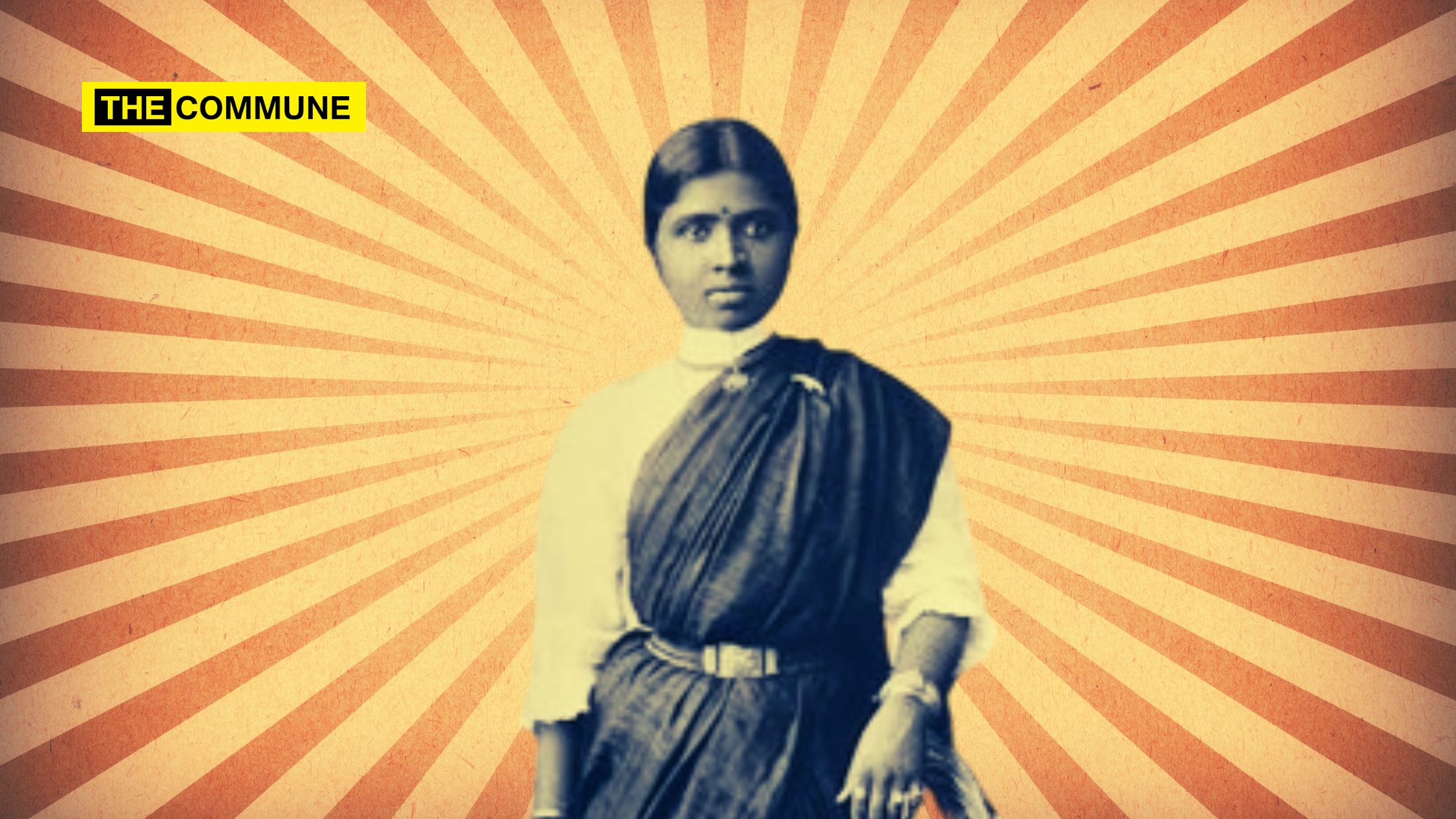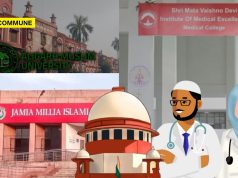
In contemporary Bharat, there are 4 categories of people.
- There are great people.
- There are great people whom we cannot talk about.
- There are great people we can talk about.
- There are great people whose greatness we cannot talk about without ascribing it to a nonexistent mentor or ideology.
Dr. Muthulakshmi Reddy belongs to category 4.
You cannot speak about her without invoking the imaginary Brahmin hegemony and, more importantly, without invoking the nonexistent greatness of a ‘little’ man. In this piece, let us take a quick look at Dr. Muthulakshmi Reddy’s greatness. Why does she need to be celebrated? We will also examine how she has traditionally been presented to us and how this utterly false narrative has been carefully built over the Dravidian basement.
Dr Reddy was born to Sri. S. Narayanaswami Iyer and Smt. Chandrammal on 30 July 1886, in the princely state of Pudukkottai. Sri. Narayanaswami Iyer was the Principal of Maharaja’s College in Pudukottai. He was keen on educating all his four children. As was the practice then, she went to a Pial school (1), which was the norm. She then progressed to a boy’s school where she learned the English alphabet thanks to the teachers who saw the potential in this little girl. It took till she cleared her First Form for her father to realise her potential. In a subsequent rollercoaster of a learning ride, Muthulakshmi was taken off school by her mother, put back in school because one of her teachers pleaded with her mother, again pulled off school when she was 13, homeschooled by her father and passed her matriculation in 1902. That year, out of the 100 students who appeared to matriculate from schools and privately, only ten cleared the exam. While Muthulakshmi wanted to go to Trichy or Palayamkottai for college, her father applied for a seat at the local men’s college. After a long, protracted struggle and an intervention by the ruler of Pudukottai, she was finally given admission to the pre-university course. It is important to note that, Sri. S. Sathyamurthi, who famously appears in an episode involving Dr Muthulakshmi Reddy (cooked up by vested interests), was her classmate at the pre-university level.
In 1907, she came to Chennai to join the Madras Medical College. Initially, the college offered her the L. M&S or the Licentiate, not the degree course. Not one to be cowed down by impediments, the young Muthulakshmi fought her way to the degree course and passed the MB & CM degree with many medals and accolades as the number one in her batch. Those days, a senior professor and surgeon in the Obstetrics department, Col. Giffard2, wouldn’t let women sit in his lectures. He would have an assistant professor lecture the women instead. When the prize and medal exams were thrown open to the women, Col. Giffard was so impressed with Muthulakshmi’s knowledge that he allowed women to sit in his classes. Dr Reddy finished her MB & CM course with flying colours, scoring 100% in her final year surgery course.
During her medical college days, she became acquainted with the freedom movement and its stalwarts. She became a favourite of Mahakavi Bharatiyar, who asked her to contribute articles for the ‘India’ magazine and invited her to speak at his home meetings. Young Muthulakshmi also got to know Smt. Sarojini Naidu, Dr Annie Besant, and many other leaders of the freedom movement.
Dr. Reddy was much ahead of her time. When Dr T Sundara Reddy, a medical doctor educated in England, asked for her hand, she famously told him, “Promise me that you would always respect me as an equal and never cross my wishes.” After being engaged for a year, Dr Muthulakshmi Reddy and Dr T Sundara Reddy married in April 1914. The couple had two sons, Rammohan and Krishnamurthy.
In 1925, she went to London on a Government of India scholarship for her post-graduate studies. Dr. Muthulakshmi Reddy was keen to study and specialise in cancer treatment. After losing her younger sister Sundarambal (25) to rectal cancer, she resolved to find a remedy for this human scourge.
There are umpteen things to discuss when discussing Dr Muthulakshmi Reddy’s greatness. The most famous episode is her moving the legislation to abolish the Devadasi service in the temples and prevent girls from being dedicated to temples. There are two versions here: what Dr Reddy says in her autobiography and while chronicling her legislative years. And two, the carefully cultivated Dravidian falsehood3 is built on a speech by someone quoting someone else and then someone else writing a book about this someone else and quoting what was quoted in the speech.
Falsehood 1: E V Ramaswamy mentored and inspired Dr Muthulakshmi Reddy to move the bill for abolishing the Devadasi system.
Dr Reddy moved this bill in 1926, when E V Ramaswamy, having resigned from Congress, was between jobs. EVR was probably busy contemplating his visit to various nations worldwide on a learning tour (1929-32). Most of us also know about his visit to Germany as part of this tour and his learning expedition to ‘certain’ beaches. On a serious note, no documentary evidence draws a remote connection between EVR and this bill.
Falsehood 2: When Dr Reddy moved this bill in the legislature, many prominent Brahmin members, including S Satyamurthi, vehemently opposed it. Dr Reddy is supposed to have retorted sharply saying, “Don’t you have sisters? Don’t you have any womenfolk in your family? Don’t you have wives? Will you send any of them to this profession?” It is said that there was a stunned silence in the legislature and this argument clinched the bill in Dr Reddy’s favour.
Satyamurthi indeed opposed certain sections of the bill. In 1929, during a discussion about certain amendments to the bill, Satyamurthi spoke about why he opposed it. He pointed to how the word ‘Devadasi’ had been defined in the bill. He feared it might include any other unmarried woman worker in the temple, like a sweeper, and hinder the service they are rendering to the temple. Therefore, he asked for this definition to be dropped in favour of a definition everyone was aware of. Apart from this one, we don’t have any other speeches Satyamurthi made on the house floor or outside. More importantly, we don’t have any other reference to S Satyamurthi except one positive reference where Dr Reddy talks about how he and Rajaji wanted her to contest the elections for the legislative in 1937 on a Congress ticket. Later, she is very critical about how Rajaji went back on his word by not allotting a seat to her.
There is no mention of S Satyamurthi except that he was one of the two people who wanted her to contest the elections on a Congress ticket. There is also another place where she says that Rajaji proved to be an opponent of social reforms in our society, but not one word about S Satyamurti (I am sure Dr Reddy would have if she indeed had to). The bill was finally passed as Madras Act XXXI of 1947, making the dedication of women to temples illegal. This was four years after S Sathyamurthi passed away.
In summary, no document worth its salt mentions Satyamurthi saying what the Dravidian ideologues say he did. And there is also no evidence that Dr Reddy retorted the way she was supposed to have.
Three things are clear:
- S Satyamurthi was not part of the house when the bill was first moved.
- S Satyamurthi spoke once during the long period this bill was under discussion. That, too, was an intervention opposing a specific amendment that was moved.
- S Satyamurthi had passed away when the legislature finally passed this bill.
So, the Dravidian trope about Dr Reddy being EVR’s student, that she had his blessing for the bill, and that she and S Sathyamurthi had a heated exchange on the floor of the legislature is nothing but a hoax, a white lie.
Whatever the Dravidian falsehoods, Dr Reddy always held the culture and history of Bharat in high esteem. In July 1936, speaking at the International Conference of Women in Paris, where women from 42 countries participated, she said that she came from a land that celebrates women’s power as Sakthi and has gods depicted as Ardhanareeshwara. According to her, these examples show the influence of women in Indian society.
In Paris, discussing the then-state of the Devadasi system, she said, “Foreigners seem to be under the wrong impression that it is an institution sanctioned by the Hindu religion. The old religious idea was one of service. That is, girls were given away to temples by all communities for pure religious service.”
While talking about her stay in Madras as a medical college student, she talks about fellow students staying at the YWCA in Poonamallee Road, “They would invite me to their rooms and lecture me about the advantages of Christianity and would persuade me to become a convert. But I was more than equal to them. “
In another instance in delivering her address to the International Congress for Women, she said that practices like Child Marriage and the Purdah system (women covering themselves with veils) are outcomes of the turbulent and warlike period in the past to protect them from the hands of invaders.
While we have taken much of this piece to burst the Dravidian white lie that Dr. Muthulakshmi Reddy is a follower of EV Ramaswami and took instructions from him on important matters, Dr Reddy is much bigger than that one legislation—the abolition of the Devadasi system. Here is a short list of the great things that Dr. Reddy accomplished.
She went to London for her post-graduation on a government scholarship. There, she studied the advancements in cancer treatment and maternity and infant care. She became the first lady to sit in the Indian legislature, the Madras Legislative Council, and served as its Deputy President.
Dr Muthulakshmi Reddy was a founding member of the Women’s India Association, which was founded in Adyar, Chennai, in 1917. She had very sharp views about the menace of alcohol and prohibition. She said, “I rise to give expression to the opinion of the enlightened women of this country regarding this question of prohibition, it is admitted by everybody that this drinking habit is harmful to the individual and to the nation from the medical and human point of view.”
In 1928-29, she successfully moved a bill for the prohibition of child marriage and to raise the year of consent. Her active discussions about this issue made some women members of the legislature start talking about raising the marriageable age of women to 18. She was a prominent voice talking about the prevalent conditions and welfare of the plantation workers in Ceylon. She visited them on a fact-finding tour in 1929 and spoke about the conditions very vocally, to the extent that the tea estate management(s) created a ruckus at the venue where she spoke.
In 1931, she launched the Avvai Home to shelter, protect, and educate orphan girls. Through Avvai Home, she also ensured that they trained teachers, midwives, nurses, health visitors, and Grama Sevikas.
In 1930, she successfully moved the Act for the Suppression of Immoral Traffic in Women and Children. She was the founder of the Vigilance Association of Madras and its rescue home, Sree Sadhana. She was also instrumental in passing legislation about the urgent need to establish a Children’s hospital in Madras.
On 8 May 1930, she resigned from the legislature, protesting against the arrest of Gandhiji. This was a time when cancer was called a disease of the old. As someone who lost her young sister of only 25 to rectal cancer, Dr Reddy resolved that she would find a remedy for this human scourge. In 1935, during the centenary celebrations of the Madras Medical College, she steered a resolution asking for a cancer hospital in Madras. That resolution hit a roadblock because the funds were diverted for other purposes. She took it upon herself to ensure that a speciality cancer care hospital was built in Madras. In 1952, the then-prime minister, Jawaharlal Nehru, laid the foundation for this great institution that continues to provide yeoman service.
As the Alderwoman of the Madras corporation, she opened a home for Leperatic and Diseased Beggers. In 1936, she started Avvai Rural Medical Service, a free medical dispensary.
The Dravidian propaganda machinery can constrict great leaders as leaders representing one caste or as anti-Hindu, Brahmin-hating people. They have tried this age-old trick on Dr Muthulakshmi Reddy to date. They tend to ignore, brush aside, or foul mouth the Brahmin ancestry of Dr Reddy. Bring EVR in as Dr Reddy’s guiding light, and mentor. As one who was responsible for her education and indoctrination and as the reason for all her success. Talk only about the imaginary exchange between her and her college mate, a colleague in the legislature, S Sathyamurthi.
Therefore, few people know much about Dr. Muthulakshmi Reddy. It is time we tore open the Dravida Maaya and brought the truth out. More importantly, we should have a special place of pride for great leaders such as Amma Dr. Muthulakshimi Reddy.
This Thirukkural seems to fit the legacy of Dr Muthulakshmi Reddy
தோன்றின் புகழொடு தோன்றுக அஃதிலார்
தோன்றலின் தோன்றாமை நன்று.
Thondrin Pugalodu Thondruga Akdilar
Thondralin Thondramai Nandru
Tirukkural, Chapter 24, Kural 236
If men must need to be born into the world, let them earn glory: as to those who earn it not, it was better for them not to have been born at all.4
The Kural or The Maxims of Thiruvalluvar by VVS Iyer.
Aneka Koti naman to this great leader on her birth anniversary today.
Notes and References
- 1Pial school, or Thinnai Pallikoodam (in Tamil), is a single-teacher school that convenes in a little platform-like structure outside any traditional Tamil house. In most cases, the school functioned in the pial of the teacher’s home.
- 2You can still see a block in Col. Giffard’s name in the Government Women’s and Children’s Hospital, Egmore, honoring his contribution to Obstetrics.
- 3It is an age-old Dravidian Party trick to speak about (baseless and falsehood) things on a stage. Then, get someone to write a book quoting what was spoken on stage so that this book becomes the source of credence to the falsehood and turns it into history/ truth.
- 4I would request the reader to read and enjoy the meaning of this Thirukkural and not get struck on the pronouns like the wokes
- Autobiography of Dr. (Mrs) S. Muthulakshmi Reddy MB & CM, Avvai Homes Publication
- Dr (Mrs) S. Muthulakshmi Reddy, My Experience as a Legislator, Current Thought Press, Triplicane (1930)
- Ma Venkatesan, Devadasi Abolition Act (தேவதாசி ஒழிப்புச் சட்டம்), Tamil, Swasam Publication (April 2024)
Raja Baradwaj is a marketing communications professional who is currently working with a leading technology multi-national company. He is an avid reader, a history buff, cricket player, writer, Sanskrit & Dharma Sastra student.
Subscribe to our channels on Telegram, WhatsApp, and Instagram and get the best stories of the day delivered to you personally.




